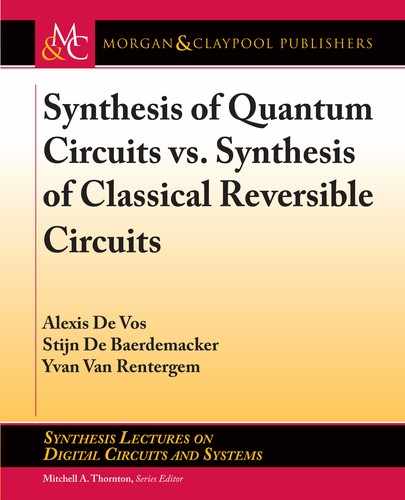
4.7. SYNTHESIS EFFICIENCY 77
U
11
D
1 0
0 c
D
1 0
0 c
1 0
0 1
U
12
D
0 0
s 0
D
0 0
0 s
0 x
1 0
U
21
D
0 s
0 0
D
s 0
0 0
0 1
y 0
U
22
D
c 0
0 1
D
c 0
0 1
1 0
0 1
;
where c and s are short-hand notations for cos.t / and sin.t/, respectively. Two blocks, that is,
U
12
and U
21
, are singular and therefore have a polar decomposition which is not unique: both x
and y are arbitrary numbers on the unit circle in the complex plane. e resulting two bZbXbZ
decompositions of U are:
0
B
B
@
1
e
ie
iy
1
C
C
A
1
2
0
B
B
@
2
1 C 1=e
2
1 1=e
2
2
1 1=e
2
1 C 1=e
2
1
C
C
A
0
B
B
@
1
1
ix
i
1
C
C
A
and
0
B
B
@
1
1=e
i=e
iy
1
C
C
A
1
2
0
B
B
@
2
1 C e
2
1 e
2
2
1 e
2
1 C e
2
1
C
C
A
0
B
B
@
1
1
ix
i
1
C
C
A
;
where e is a short-hand notation for c Cis. One can easily check that these decompositions
are correct iff xy D 1. is leaves a 1-dimensional infinitum of decompositions. e fact that
some matrices U have an infinity of decompositions is further discussed in the next chapter (i.e.,
Chapter 5).
4.7 SYNTHESIS EFFICIENCY
Both synthesis methods (i.e., the primal one and the dual one) decompose an arbitrary element
of a given Lie group G (here the group U(n) of the n n unitary matrices) into a product of
three building blocks: a member of a subgroup G
1
, a member of a subgroup G
2
, and a member
of a subgroup G
3
. By merely substituting in (2.6) “order” by “dimension” and replacing products
by sums and division by subtraction, we obtain the overhead formula for Lie groups:
dim.G
1
/ C dim.G
2
/ C dim.G
3
/ dim.G/ ;
..................Content has been hidden....................
You can't read the all page of ebook, please click here login for view all page.
